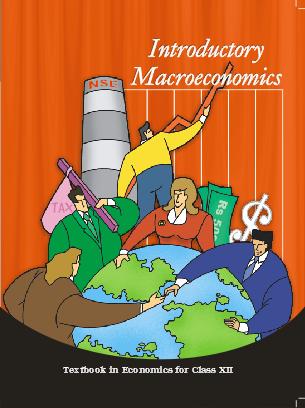NCERT Solutions class 12 Economics Open Economy Macroeconomics Class 12 Economics book solutions are available in PDF format for free download. These ncert book chapter wise questions and answers are very helpful for CBSE board exam. CBSE recommends NCERT books and most of the questions in CBSE exam are asked from NCERT text books. Class 12 Economics chapter wise NCERT solution for Economics part 1 and Economics part 2 for all the chapters can be downloaded from our website and myCBSEguide mobile app for free.
Download NCERT solutions for Open Economy Macroeconomics as PDF.

Microeconomics
- Introduction
- Theory o Consumer Behavior
- Production and Costs
- Theory of Firm Under Perfect Competition
- Market Competition
- Non Competitive Markets
Macroeconomics
- Introduction
- National Income Accounting
- Money and Banking
- Income Determination
- Government Budget and Economy
- Open Economy Macroeconomics
CHAPTER Six Open Economy Macroeconomics
- The Balance of Payments
- BoP Surplus and Deficit
- The Foreign Exchange Market
- Determination of the Exchange Rate
- Flexible Exchange Rates
- Fixed Exchange Rates
- Managed Floating
- Exchange Rate Management: The International Experience
- The Determination of Income in an Open Economy
- National Income Identity for an Open Economy
- Equilibrium Output and the Trade Balance
- Trade Deficits, Savings and Investment
NCERT Solutions class 12 Economics Open Economy Macroeconomics
1. Differentiate between balance of trade and current account balance.
2. What are official reserve transactions? Explain their importance in the balance of payments.
3. Distinguish between the nominal exchange rate and the real exchange rate. If you were to decide whether to buy domestic goods or foreign goods, which rate would be more relevant? Explain.
4. Suppose it takes 1.25 yen to buy a rupee, and the price level in Japan is 3 and the price level in India is 1.2. Calculate the real exchange rate between India and Japan (the price of Japanese goods in terms of Indian goods). (Hint: First find out the nominal exchange rate as a price of yen in rupees).
5. Explain the automatic mechanism by which BoP equilibrium was achieved under the gold standard.
6. How is the exchange rate determined under a flexible exchange rate regime?
7. Differentiate between devaluation and depreciation.
8. Would the central bank need to intervene in a managed floating system? Explain why.
9. Are the concepts of demand for domestic goods and domestic demand for goods the same?
10. What is the marginal propensity to import when M = 60 + 0.06Y? What is the relationship between the marginal propensity to import and the aggregate demand function?
11. Why is the open economy autonomous expenditure multiplier smaller than the closed economy one?
12. Calculate the open economy multiplier with proportional taxes, T = tY, instead of lump-sum taxes as assumed in the text.
13. Suppose C = 40 + 0.8Y D. T = 50, I = 60, G = 40, X = 90, M = 50 + 0.05Y
(a) Find equilibrium income
(b) Find the net export balance at equilibrium income
(c) What happens to equilibrium income and the net export balance when the government purchases increase from 40 to 50?
14. In the above example, if exports change to X = 100, find the change in equilibrium income and the net export balance.
15. Explain why G – T = (Sg – I) – (X – M).
16. If inflation is higher in country A than in Country B, and the exchange rate between the two countries is fixed, what is likely to happen to the trade balance between the two countries?
17. Should a current account deficit be a cause for alarm? Explain.
18. Suppose C = 100 + 0.75Y D, I = 500, G = 750, taxes are 20 per cent of income, X = 150, M = 100 + 0.2Y. Calculate equilibrium income, the budget deficit or surplus and the trade deficit or surplus.
19. Discuss some of the exchange rate arrangements that countries have entered into to bring about stability in their external accounts.
NCERT Solutions for Class 12 Economics
NCERT Solutions class 12 Economics Macro Introduction PDF (Download) Free from myCBSEguide app and myCBSEguide website. Ncert solution class 12 Economics includes text book solutions from both part 1 and part 2. NCERT Solutions for CBSE Class 12 Economics have total 12 chapters. 12 Economics NCERT Solutions in PDF for free Download on our website. Ncert Economics class 12 solutions PDF and Economics ncert class 12 PDF solutions with latest modifications and as per the latest CBSE syllabus are only available in myCBSEguide
CBSE App for Students
To download NCERT Solutions for class 12 Physics, Chemistry, Biology, History, Political Science, Economics, Geography, Computer Science, Home Science, Accountancy, Business Studies and Home Science; do check myCBSEguide app or website. myCBSEguide provides sample papers with solution, test papers for chapter-wise practice, NCERT solutions, NCERT Exemplar solutions, quick revision notes for ready reference, CBSE guess papers and CBSE important question papers. Sample Paper all are made available through the best app for CBSE students and myCBSEguide website.

Test Generator
Create question paper PDF and online tests with your own name & logo in minutes.
Create Now
Learn8 App
Practice unlimited questions for Entrance tests & government job exams at ₹99 only
Install Now